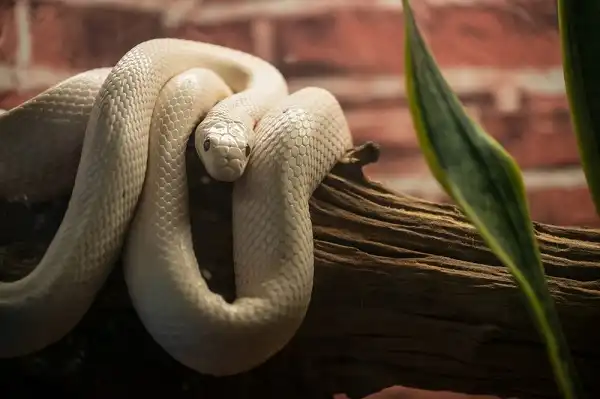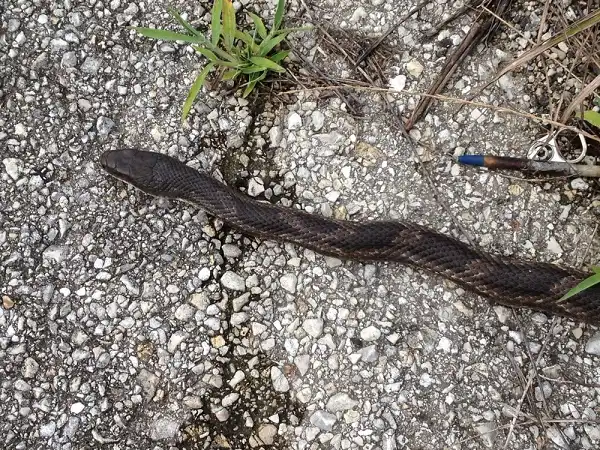If you live in Texas, chances are you’ve seen a rat snake before. These non-venomous snakes are common in the Lone Star State and can be found in a variety of habitats. While they may not be the most popular snake around, they play an important role in our ecosystem. In this blog post, we’ll learn more about rat snakes and why they’re worth knowing about!

Texas Rat Snake Description
Texas rat snakes, also known as black rats, can be found in many parts of the Lone Star state. These non-venomous snakes are quite common and can be identified by their long, slender bodies and triangular heads, and have distinct markings down their backs that vary from light gray to olive or brown. This species is often active during the day and can be seen sunning themselves on rocks or logs, but they will also hunt at night when temperatures are cooler. Rat Snakes are an important part of Texas’ ecosystems as they help regulate rodent populations by preying upon them; thus controlling disease vectors like the hantavirus and bubonic plague. As such it is essential that we protect this species so it may continue to fulfill its important role within our environment!
Texas Rat Snake Habitat
Texas Rat Snakes are incredibly adaptable and can be found all over the state of Texas. From marshes and swamps to arid deserts, these reptiles will make their homes in a variety of habitats. They can be seen in grasslands, woodlands, shrublands, hillsides, canyons, and even urban areas. Generally, they prefer moist habitats with plenty of cover such as bushes or tall grasses, but they are also known to inhabit drier environments as well. The ideal habitat for a Rat Snake is one that provides plenty of hiding places along with ample food sources. Vegetation such as trees and shrubs provide shelter from predators while rocks and logs offer basking spots for these cold-blooded creatures when temperatures rise. In the wild, these snakes may also reside near water sources like ponds or lakes to stay hydrated during the hot summer months. In addition to their natural habitats, Rat Snakes have adapted to living in close proximity to humans too – alongside barns, farmhouses, and outbuildings they are frequently spotted around suburban gardens and yards where they often come into contact with people. While this species tends not to be aggressive toward humans, it is important to remember that they should not be handled or disturbed unnecessarily as this could cause them undue stress.
Texas Rat Snake Diet
Texas Rat Snakes are opportunistic feeders and will consume a variety of prey items. Their diet includes small rodents such as mice, voles, and rats, as well as birds’ eggs, lizards, frogs, and sometimes even other snakes. When hunting, these creatures rely heavily on their keen sense of smell to detect potential prey items both aboveground and underground. Additionally, they possess binocular vision which enables them to focus on prey from a distance before striking it with their quickly-flickering tongues. Rat Snakes typically feed during the cooler periods of the day or night in order to conserve energy; however, they may also hunt during the heat of the day if food is scarce. Once they have located a potential meal they will capture it with highly-developed constricting abilities which involve squeezing the prey tightly until it suffocates. This behavior has earned this species its nickname – “the squeeze snake”. In addition to preying upon small animals, Texas Rat Snakes will also scavenge for food if necessary. These reptiles are adept climbers and can often be seen scaling trees or rocks in search of an easy meal like bird’s eggs or insect larvae. They also have sharp hearing which can help them locate potential sources of sustenance even when out of sight.

Texas Rat Snake Size
Texas Rat Snakes are a species of medium-sized snake that can reach sizes up to and over 4.5 feet in length in adulthood. The size of a Texas Rat Snake depends on several factors including its age, gender, and living environment. Subadult snakes tend to be smaller than adults as they have yet to reach full maturity; however, males are generally larger than females regardless of their age. In addition, these reptiles grow bigger in areas with plentiful food sources as they require more energy for development compared to those living in less hospitable regions. Aside from being influenced by natural factors, human intervention can also affect the size of these creatures too – unfortunately, habitat destruction has been known to lead to increased competition for food resources which ultimately results in smaller adult specimens. Thus it is important for landowners to implement safe management practices that will benefit both Rattlesnakes and other wildlife too!
Texas Rat Snake Lifespan
Texas Rat Snakes are relatively long-lived creatures, with an average lifespan of around 15-20 years in the wild. However, in captivity, they can live up to 25 years or even longer if provided with appropriate care. This species has a late maturity rate, meaning they won’t reach their full size until they’re at least 5-7 years old. The longevity of a Texas Rat Snake is determined by various factors including its environment, diet, and general health. In addition to having access to enough food and shelter, these reptiles also require regular temperature and humidity levels that mimic their natural habitat in order for them to stay healthy and thrive. They also need fresh water available at all times as hydration is essential for any kind of snake species. Finally, since Texas Rat Snakes are nonvenomous they don’t possess any means of defending themselves against predators; thus if attacked they must rely on their speed and agility when escaping danger which can sometimes be difficult if they’re smaller or older specimens.
Texas Rat Snake Behavior
Texas Rat Snakes are relatively docile creatures and will usually avoid confrontation by fleeing when threatened or feeling startled, although they can become defensive if cornered or handled. When confronted, these snakes will often coil their bodies and shake their tails to give the appearance of a rattlesnake in order to scare off potential predators. They may also flatten their heads and necks, hiss loudly, and lunge forward if further provoked. In terms of social interaction between individuals, Texas Rat Snakes are mainly solitary creatures; however, males may sometimes compete for access to females during the breeding season which usually occurs from April through May. Courtship behavior typically involves ritualized combat where two males face off in an upright position before attempting to push each other down. This behavior is known as “combat dancing” and it serves as a means of asserting dominance over one another while also displaying physical strength. Finally, Texas Rat Snakes are ectothermic animals meaning that they rely on external sources like sunlight or warm rocks in order to maintain their body temperature; therefore individuals living in areas with milder climates tend to be more active than those inhabiting regions with colder temperatures as it’s difficult for them to stay warm during winter months.

Texas Rat Snake Speed
Texas Rat Snakes are surprisingly fast creatures with the ability to both climb and travel quickly over land. While they may not be able to reach the same speeds as some of their more agile counterparts, these reptiles still possess impressive reflexes and quickness that allow them to escape danger or capture prey with relative ease. When moving across the ground, Texas Rat Snakes can reach top speeds of up to 10mph (16km/h), although this varies depending on the terrain; for instance, these creatures have been known to move faster on smooth surfaces such as asphalt compared to rough terrains like gravel or dirt. Furthermore, their bodies are incredibly flexible which helps them maneuver around obstacles or squeeze through tight spaces in order to maximize their speed. When it comes to climbing, Texas Rat Snakes can also ascend vertical surfaces with remarkable agility thanks in large part to their sharp claws and prehensile tails; this allows them to cling onto trees, rocks, and other objects while they traverse upwards at speeds of up to 5mph (8km/h). Additionally, the combination of powerful muscles and adhesive scales further aids in their ability to climb rapidly since it gives them extra leverage when gripping onto surfaces.
Texas Rat Snake Hunting
When it comes to hunting, Texas Rat Snakes are ambush predators that rely heavily on their sense of smell and vision when capturing prey. To start, these reptiles wait patiently in hiding before striking out swiftly with a lightning-fast strike once t

hey’ve located suitable food sources. Once within range, these snakes employ their incredible reflexes to grab their prey with their sharp teeth and powerful jaws. Following this, they use constriction techniques to subdue their victims before consuming them whole; this includes tightly wrapping themselves around the hapless animal in order to asphyxiate it into submission. Additionally, it’s also been observed that Texas Rat Snakes will sometimes use venom secretion as a means of subduing larger prey items such as birds or small mammals. When out hunting, these reptiles are active both day and night; however, they must rely mainly on olfactory cues at night due to their limited nocturnal vision. During the day, they make use of their excellent eyesight to spot potential victims from far away while simultaneously using their keen sense of smell to detect pheromone signals which can help them distinguish between potential food sources and predators alike.
Conclusion
In conclusion, Texas Rat Snakes are incredibly adaptive and resourceful creatures that can be found in many different habitats across the southern United States. These reptiles boast impressive speed and reflexes on both lands and up vertical surfaces, as well as a keen sense of smell and vision which helps them to locate food sources with relative ease. Furthermore, their ability to employ venom secretion or constriction techniques when hunting further adds to their effectiveness in capturing potential prey items; all these traits combine together to make Texas Rat Snakes extremely proficient predators! Ultimately, it’s easy to see why these creatures are so successful at surviving in the wild – they truly embody what it means to be a resilient animal!
Frequently Asked Question

